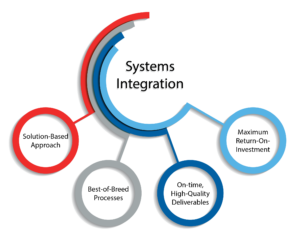SYSTEM INTEGRATION
Modern business environment generates the need to use different IT solutions for different purposes to ensure effective work of an enterprise. In this respect, system integration is a vital point to consider, whether you are planning to add new functionality to the IT solutions already in use, or implement new software.
System Integration Methods
- Horizontal integration (or Enterprise Service Bus)
- Vertical integration
- Star integration
- Point-to-Point (App-to-App) Integration
- Common Data Format integration
Sample Integrations
- Magento & Quickbooks
- Magento & SugarCRM
- SugarCRM & QuickBooks
- Magento & OpenERP (Odoo)
- OpenERP (Odoo) & WooCommerce
- Etc.
7-Phase System Integration Life Cycle
A process to contact distinct systems that ensures that integrated system would function flawlessly with the other one. This process allows the coordination of different computing systems and software applications functionally. System integration mainly contains seven distinct and crucial phases
Requirement and Specification
Before initiating to working on the actual system integration ; list out the detailed requirements given by the customer. Efficiency is required in framing the requirements of both the systems that are to be integrated to make this process easy and seamless.
Feasibility Analysis
Once the requirements, definitions and specifications referencing the systems to be integrated are listed down, feasibility analysis takes place. The feasibility study includes complete analysis of the system integration project based on the intense research to support the decision making process.
System Architecture Development
This is the system construction phase which includes system architecture plan regarding how the system should be integrated to the other comprehensive system. Blueprints of the integration plan are created that also includes the proposed architecture plan and much more.
Management Plan
Once the complete plan of system integration is released, this phase comes into existence. Risk factor calculations, project execution plan, alternative listing etc. are the processes conducted in this phase.
System Integration Design
This is probably the fifth step of system integration life cycle that includes logical and physical designs created for the system that are to be integrated. Preliminary designs, detailed designs, system tests etc. are the processes included in this phase.
Implementation
Once the system design is ready, it is verified implemented and thoroughly. Before deploying the integrated systems, it is tested to give error free solution to the customer. In case of errors, the system is again verified by the integrators making it error free. The final report consists of error free integrated system.
Evaluation
This is the final step where the functioning of the integrated system is checked thoroughly. The evaluation phase includes checking, maintaining, modifying and enhancing of the components.
System integration is the process that requires extensive research. Only the perfect research results in the successful system integration.

